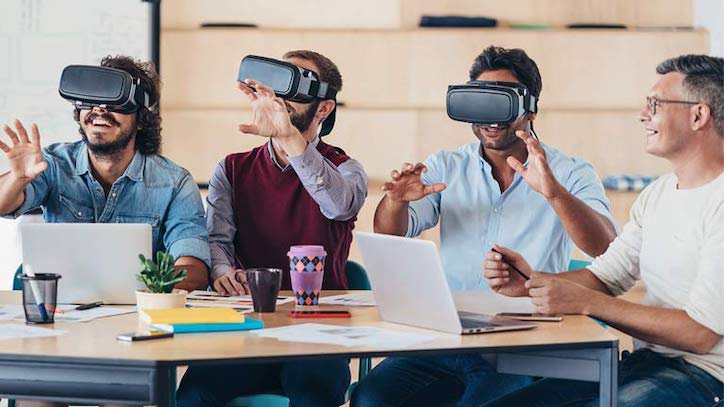
Industry leaders are exploring how these emerging technologies can enrich existing business processes. What they’ve honed in on is that the metaverse has remarkable potential to transform the future of digital learning and work. It’s built on the integration of augmented reality (AR) and virtual reality (VR) in the physical world. Extended reality (XR) is already an active player in employee training and development in several industries. While XR training is making a breakthrough in many sectors, it can move beyond safety, critical care, or crisis response industries and situations to deliver real-world value to employee training and development for sectors such as real estate, retail, tourism, and more.
So, get ready now, as we are going to share everything that you need to know about the fascinating realm of extended reality (XR).
What is Extended Reality (XR)?
Extending reality, which is also known as XR, is a concept that combines computer-generated parts and those from the actual world to create a realistic setting for immersive investigation. A common phrase, mixed reality (MR), augmented reality (AR), and virtual reality (VR) are all included in the category of immersive learning technologies. This includes presenting virtual information in three dimensions or overlaying it with interactive data using a device.
- Virtual Reality (VR): The users of virtual reality (VR) can experience an entirely immersive digital world that makes them feel exactly like they are presently in an entirely distinct location or situation
- Augmented Reality (AR): Augmented Reality (AR) improves the perspective of their user’s surroundings by incorporating digital information into the real world.
- Mixed Reality (MR): MR is the combination of both VR and AR, which means it includes the elements of both. It enables the real time interaction between the virtual objects and real-world items.
Through the effective use of these technologies, organizations can create comprehensive training programs that surpass the standards of engagement and effect of traditional approaches.
The Importance of Diversity and Inclusion Training

Diversity and inclusion are the essential components of an effective work environment. Companies that set a high priority on diversity and inclusion usually have employee satisfaction, enhanced team performance, and higher levels of innovation. Traditional D&I training techniques, including seminars and online courses, frequently come up short of bringing about the long-lasting behavioural shift required to establish genuinely inclusive work environments. These approaches can be passive, and workers may find it difficult to relate to the content personally at times.
This is where XR becomes essential. XR could be helpful in bridging the gap between awareness and action by offering a more dynamic and interesting learning environment. Furthermore, this will result in more significant and long-lasting behavioural changes.
How XR Enhances Diversity and Inclusion Training
- Immersive Learning Environments
Through XR, organizations may establish immersive learning environments that provide staff members access to various opinions and circumstances. With virtual reality (VR), for instance, a worker might put themselves in the shoes of a co-worker from an entirely different culture and experience directly the difficulties they could have at the workplace. Deeper awareness of the value of diversity and inclusion as well as empathy may be developed by this immersive experience.
- Simulating Real-World Scenarios
XR could be used to replicate real-world situations that employees are likely to come across at the workplace. In a Virtual Reality (VR) scenario, for example, one may have to facilitate a discussion about cultural differences or deal with unconscious prejudice in a team meeting. Furthermore, employees can develop the abilities and self-assurance necessary to manage comparable circumstances in the real world by practising these scenarios in a secure virtual environment.
- Personalized Learning Experiences
Offering individualized learning experiences is one of the main benefits of XR. So, to make sure that the material in training modules is up-to-date and beneficial, they can be customized to the unique requirements and job duties of the employees. Also, a manager needs to get training on leadership techniques for creating an inclusive team culture, for instance, in a different setting from that of an entry-level employee.
- Data-Driven Insights

Analytics solutions that monitor employee interactions and performance during training are often included with XR platforms. Organizations may use these data-driven insights to find out where their employees can benefit from more training or guidance. Companies may constantly enhance their D&I training initiatives to make sure that they are successful and meaningful by evaluating this data.
- Engagement and Retention
Low retention of the content is sometimes a consequence of traditional training techniques’ inability to keep their employees engaged. On the other hand, XR provides an interactive and captivating experience that may grab the attention of the workers and enhance the learning process. The immersive quality of XR aids in knowledge retention as well since engaged personnel are more likely to recall events in which they took part.
- Overcoming Biases
Overcoming unconscious biases is considered one of the major obstacles in D&I training. In this context, XR may be a very effective tool since it gives employees an environment that is secure to face their prejudices. VR may be used, for instance, to simulate making judgments during the recruiting process, when an employee’s selections could indicate prejudices. Employees can attempt to overcome these prejudices in real life by recognizing and addressing them in a virtual setting.
- Global Accessibility
- Because XR technology is accessible from anywhere in the world, it is an invaluable resource for many multinational corporations with a diverse workforce. The ability for workers from various locations to take part in the same training session guarantees that the organization’s D&I initiatives are consistent. Moreover, XR is adaptable to several languages and different cultural contexts, which increases its usefulness in varied work environments.
The Future of D&I Training with XR

Expect XR to become more and more integral to training initiatives as long as firms maintain their focus on diversity and inclusion. When it comes to tackling the intricate and complex challenges associated with D&I, XR is a perfect tool because of its immersive and interactive nature. XR offers the ability to significantly alter corporate culture by giving staff members a more impactful and engaging learning environment.
As XR technology advances and becomes more widely available, we will probably see an increase in the number of businesses implementing it for D&I training. The effect of D&I activities is anticipated to increase as long as this trend continues to exist, assisting companies in establishing more diverse and inclusive work environments for all employees.
Conclusion
The use of Extended Reality (XR) in training for diversity and inclusion is transforming how businesses do it. XR may assist staff members in gaining a better comprehension of diversity and inclusion through immersive, personalized and data-driven learning experiences, which can result in more significant changes in behaviour. Even if there are obstacles in the way of XR implementation, its advantages make it an invaluable resource for any company aiming to promote a more diverse workplace. XR is positioned to evolve into a key component of successful D&I training programs as advances in technology are opening the door to a more inclusive future.

